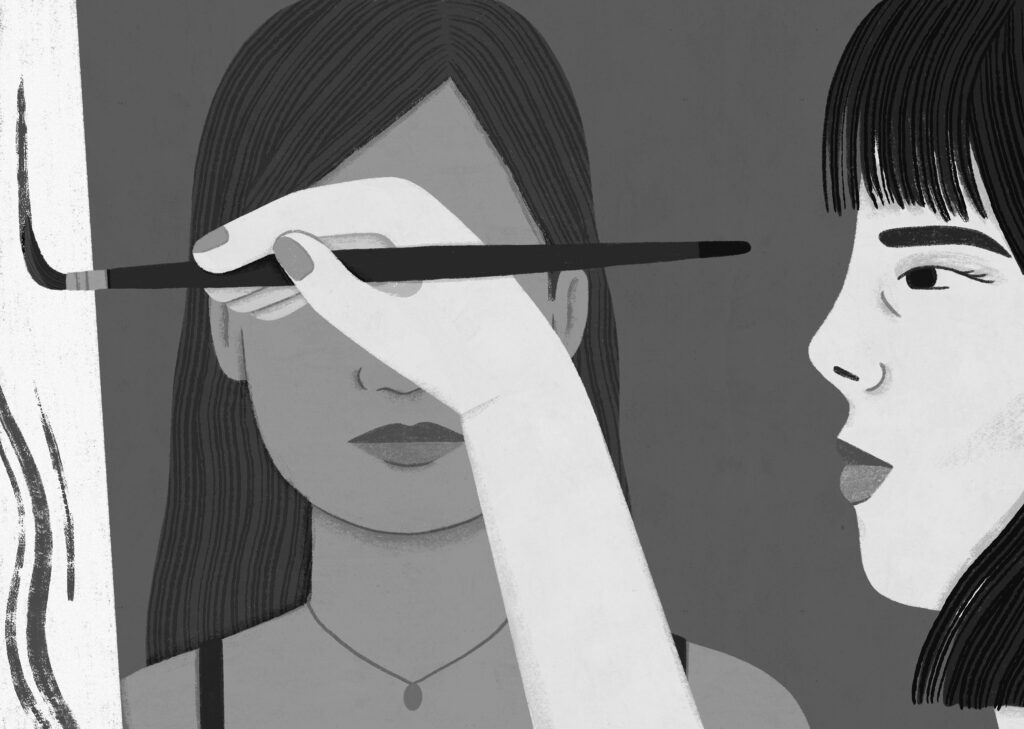One sunny afternoon, in Lynne Kutsukake’s The Art of Vanishing, two art students take their sketchbooks to a park in Tokyo. Akemi is a fastidious realist, best at illustrating anatomical diagrams for medical textbooks, and so she focuses on the tiny insects and plant life on the ground. Sayako — impetuous, romantic, with a fondness for Caravaggio — is unimpressed with her friend’s pedestrian efforts. “Why are you always looking down at your feet?” she wants to know. When Sayako reveals her drawing, Akemi is discomfited to see her own likeness staring back at her: somewhat slapdash, lacking in discipline, but undeniably truthful. “I had to admit she had captured in those rapid strokes not so much my physical likeness but something of my state of mind,” Akemi recalls. “My concentration, my earnestness, my sticky determination.”
The Art of Vanishing, Kutsukake’s second novel, is about the relationship between dutiful, studious Akemi and the hotheaded idealist Sayako. It is reminiscent of Elena Ferrante’s My Brilliant Friend and Sally Rooney’s Conversations with Friends, not only for its focus on female friendship but for the dynamics between the central characters. In all three novels, the narrator, withdrawn and analytical, becomes a sort of semi-transparent lens through which we see her more dynamic and impulsive counterpart. Critics like Suzanne Berne have suggested that this pairing represents the divided feminine psyche or the two halves of female creativity: heart and mind, id and superego, chaos and control. Akemi is fascinated to the point of obsession by Sayako’s spirited rebellion against all forms of convention, and the story that she shares is partly a sublimated love letter to a muse.
But, ultimately, who is the muse, and who is the storyteller? After the incident at the park, Sayako decides that people are her forte and asks Akemi to sit for a series of paintings. The beholder becomes the beheld. This is a mixed blessing for Akemi, who is intensely self-conscious about a facial birthmark, which she spends hours every morning covering with makeup. In fact, as the novel’s title suggests, the birthmark is only a spur to Akemi’s larger fantasies of self-effacement: even as a first-person narrator she is oddly insubstantial, conspicuously inconspicuous, a beachcomber sweeping up her own footprints. Sayako’s paintings, and her friendship more generally, act as a balm to Akemi’s ghostly sense of self, lending her form and identity. Then Akemi discovers that her friend has painted the forbidden birthmark, leading to an intense falling-out. “It’s not about you,” Sayako argues unapologetically. “It’s art.”

To observe is not necessarily to see.
Paige Stampatori
The pleasure of being seen; the mortification of being perceived! The novel plays with these networks of art and artist, seer and seen, desire and object in a way that evokes Céline Sciamma’s film Portrait of a Lady on Fire, from 2019, which dramatizes a tragic love affair between a painter and her subject. The tragedy here, however, is that Akemi and Sayako’s relationship exists in ghostly hints, intimations, perhaps even only in Akemi’s imagination. In the end, we never know. Whatever might have been is cut short when Sayako is swept up into a cult of bizarre performance artists. The group, Akemi observes, is “anti-capitalism, anti-bourgeois, anti-war, anti-materialism, anti-corporatism, anti-everything as far as I could tell.” Their leader, a messianic charlatan named Nezu, is given to gnomic philosophical pronouncements: “Art should leave no trace of itself. It should not aim for anything.”
The Art of Vanishing, unlike Nezu, aims for many things at once. It is partly a Bildungsroman. When Akemi returns home from Tokyo, she feels, like David Copperfield, both alienated from her provincial origins and unwelcome in the bustling metropole. It also resembles, at times, a novel of manners. Kutsukake renders a lifelike picture of 1970s Japan while dissecting, with Austenian precision, the fraught social relations among its people. In one excruciating scene, Akemi’s working-class father — wanting to justify his daughter’s expensive big-city education — insists that she draw a picture of the visiting neighbours’ son, an awkward, lumbering type, who is as embarrassed about the whole affair as Akemi. Or so she thinks: as she sketches, she realizes that he is leering at her, not shy at all, but an audacious lecher having a laugh at her expense. The consummate observer of detail has gotten it entirely wrong.
The point is that observation is not understanding; or, as one of Akemi’s teachers puts it, “To look was not enough, we had to see.” Perhaps the most intriguing thing about The Art of Vanishing is that it is a beautifully mimetic novel about the limits of mimesis. Akemi looks in abundance, but she cannot see. With loving fidelity, she reconstructs the world around her yet fails to grasp the essential truth about the neighbour’s son, about Nezu and his cult, even about Sayako and her family — not despite her focus on minutiae but because of it. As Sayako points out, Akemi is always looking at her feet, missing the forest for the trees. Hence the narrative frame is suffused with regret, as she looks back and wishes she might have done things differently. “If only I could just erase it all, the way I could rub out my stray pencil marks or poorly drawn lines until the paper was blank again,” Akemi muses years later. “But life is not like that, it seems.” The joy of art, in other words, is that it need not imitate reality; at its best, it’s better.
Richard Joseph lives and studies in Montreal.

